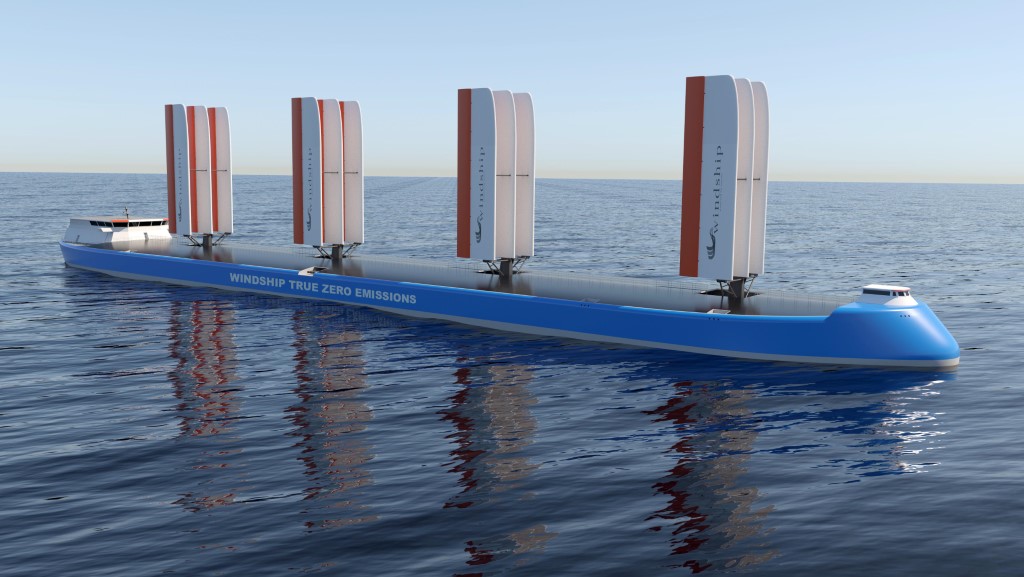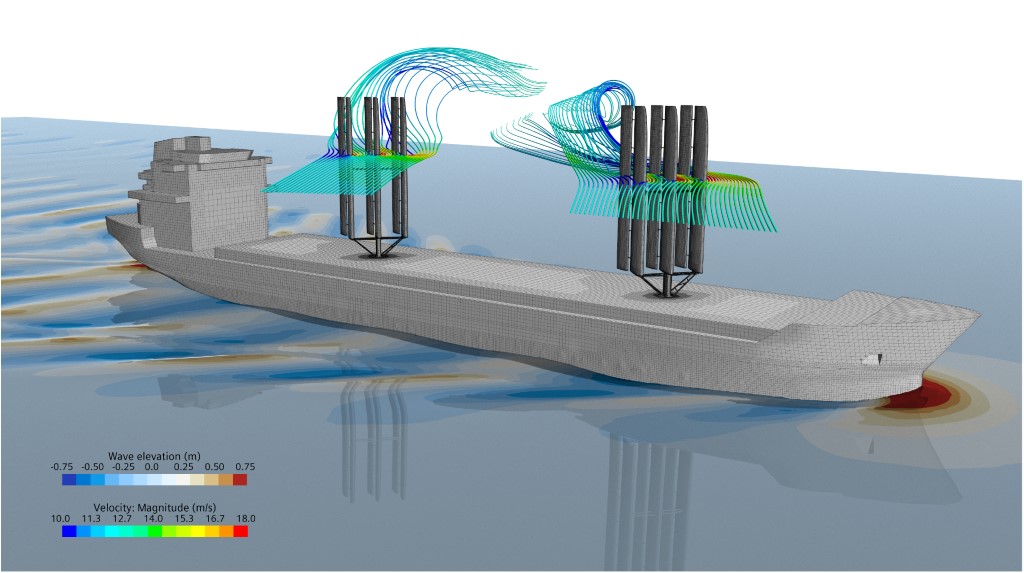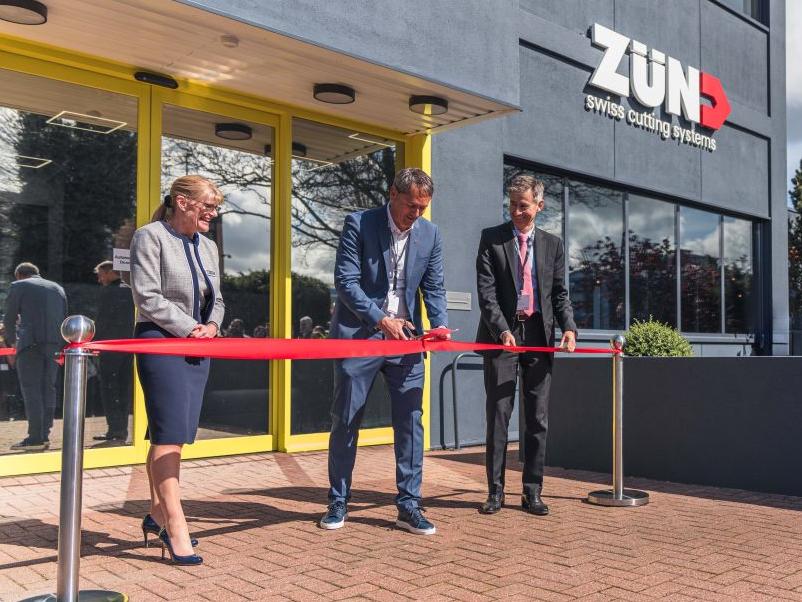Creating a Tesla of the seas
Computational fluid dynamics specialists, Cape Horn Engineering explain how the latest innovative wind propulsion technologies can maximise the efficiency of renewable energies and help reduce shipping industry emissions.
As environmental demands are calling for greater renewable and sustainable energy across the world, specialist technologies are at the forefront of new design solutions. With shipping now accounting for over 3% of global CO2 emissions, and still increasing, innovative designs such as Wind Assisted Ship Propulsion (WASP) can maximise the efficiency of renewable energies, which are set to revitalise an industry under pressure to reform.

The sail power concept developed by British company, Windship Technology has evolved the latest advancements in wind turbine blade design with high-performance composite materials. Using its expertise in ship design, fixed wing sail technology and composite technology, Windship has developed a vertical aerofoil technology to harness the wind, together with an auxiliary power system which allows significant reductions in engine power to be made whilst maintaining the same speed, maximising fuel savings and reducing emissions.
The mast rigs are highly engineered for performance, strength, lightweight and efficiencies, to ensure maximum driving force. The composite mouldings are built from highly engineered E-glass with a 100kg/m3 PET core and epoxy infusion. Each rig comprises a rotatable spar base system and three aerodynamic solid wing sails. Each wing sail has a structural leading edge, a main internal spar and three trailing edge flaps. The angular position of the spar can be adjusted as required, as can the angular position of the trailing sections. Each rig is a three-wing foil set of 36m to 48m in height, depending on the size of the ship, providing a significant thrust to propel the ship through the water.
Windship Technology, technical director, Simon Rogers and his design team developed and tested the company’s patented triple-wing rig at the Wolfson Unit in Southampton. The technical team has further developed a new diesel electric ship drive system that eliminates CO2, NOX, SOX and particulate matter to ‘true zero’ whilst also incorporating large solar arrays, carbon capture, optimised hull shapes and specialised weather routing software into the overall design. These new designs could revolutionise the way bulk carriers and tankers carry goods across the world’s oceans.
Creating a buzz in CFD
Computational fluid dynamics (CFD) is a crucial support for naval architects to optimise designs for critical elements, such as weight-saving, performance predictions, reducing emissions and ship optimisation. Cape Horn Engineering is a leading consultancy, specialising in CFD and related marine technology solutions, offering a holistic analysis of the benefits of wind propulsion technologies (WPT). Its expertise extends to optimise the design of many composite vessels including racing yachts, sailing yachts, power boats, superyachts, and renewable energy structures. The company has been at the core of simulation-based America’s Cup and Ocean Racing design campaigns for over 15 years. Similarly, it has vast experience in ship hydrodynamics, having been involved in yacht and ship design for the last two decades.
Cape Horn Engineering specialises in high-fidelity RANS-based simulation techniques where accurate forces and moments are obtained for the given shape candidates and operating conditions. It uses Siemens PLM’s STAR-CCM+ software package and has access to a large high performance computing cluster.
The company formed part of the Windship development team commissioned to run an extensive CFD programme to further improve the design of the composite solid wings in 2020. Many different design parameters and operating conditions were compared in the first phase of the optimisation: varied wing geometry, with parameters such as chord length, main/flap element chord ratio, section profiles, wing-to-wing spacing and element gap size were investigated until the highest performing geometry was found. The study also found the optimum operating conditions and explored many variations of wind speed, wind direction, wing angle and flap angle to find the maximum thrust capabilities of the WASP device. A double-digit percentage improvement in the aerodynamic performance of the wing assembly was obtained.

Cape Horn Engineering has recently announced its new simulation workflow which will assist Windship Technology in the next phase of its developments. The design of hull features, such as skegs or bilge keels may be required to balance the transversal instability induced by the installation of the WPT. Having a CFD model comprising of both the hydrodynamic and aerodynamic artefacts of the design will allow highly targeted design optimisations.
“Currently, wind propulsion systems and ship design are considered as two entities, hence they are designed independently,” states Rodrigo Azcueta, managing director of Cape Horn Engineering. “Ideally, they should be designed as a whole from the earliest stage, due to the dependency of each aspect on the other. Several factors need to be accounted for, including the aerodynamics of the thrust producing devices, the vessel hydrodynamics, propulsion system and the optimal routing.
“Simulation techniques are needed to optimise the design and routing. The optimisation process and predicted potential performance will determine the optimal operational points resulting in the lowest required engine power, fuel consumption and total emissions. Our new simulation can be used when developing new WASP devices, and with any specific vessel in consideration, as the designs can be specially tailored to suit the ships characteristics and operating conditions. We are proud to be involved in such innovative wind propulsion projects to reduce emissions for the shipping industry.”
The next phase of the CFD design optimisation, currently underway will use Cape Horn Engineering’s new simulation and take the Windship concept into consideration as a whole, including ship hydrodynamics, engine and propulsion, aerodynamics and optimal routing. The operating conditions for the vessel will be the advance speed, drift, heel and rudder angles. Furthermore, windage on superstructures and the added resistance due to sea state will be modelled and taken into account.
The simulation workflow directly compares the efficiency of WASP devices, taking into account the most important effects of adding the wings, Flettner rotors or any other type of wind powered device to the vessel. Both the water flow experienced by the hull at a given vessel speed and the air flow experienced by the hull top sides, superstructure and WASP devices, at a certain wind speed and direction, are modelled simultaneously in a single simulation.
The wind of change
The wind conditions above the water surface are modelled with an accurate wind profile considering the atmospheric boundary layer wind gradient, which results in a variable wind speed and direction at different heights. In the simulations, the vessel is sailing at constant speed, and an actuator disk models the effect of the propeller. Depending on the vessel resistance and the amount of thrust generated by the WASP devices, the actuator or virtual disc model determines the propeller revs/min and propeller torque and thus delivered power.
The simulation further considers the deformation of the free surface of waves generated by the vessel, the dynamic sinkage and trim, the drift or leeway angle, the heel angle and the rudder angle to keep a constant course. Thus, six degrees of freedom are considered.
The wind forces on the hull, superstructure and WASP devices induce the drift and heel angles, with the rudder angle changing during the simulation with the application of a PID controller, balancing the yaw moment of the whole system. The vessel speed is constant with the propeller revs/min, and therefore torque and power, responding to the drag of the hull and thrust from the WASP device. The thrust produced by the propeller balances the degree-of-freedom in direction of travel.
When the simulation converges to a quasi-steady solution, different WASP configurations can be directly compared by comparing the delivered power of the propeller and thus a direct measure of the fuel (and emissions) saving potential can be assessed.









